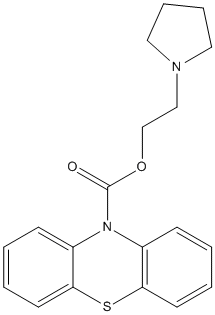N-10-Phenothiazine-2-Pyrrlidinylethyl-carbamate
(Compound 11 Darvesh et al. 2008) some Antagonist activity at muscarinic M 5-1-4 receptors histamine serotonine receptors. Ki BCHE 0.65 micro M (for comparison Donepezil 2.21 for BCHE and 0.024 for ACHE), Ka ACHE 4600 M-1min-1 (for comparison rivastigmine 1130 M-1min-1)
General
Type : Phenothiazine,Carbamate,Sulfur Compound
Chemical_Nomenclature : 2-pyrrolidin-1-ylethyl phenothiazine-10-carboxylate
Canonical SMILES : C1CCN(C1)CCOC(=O)N2C3=CC=CC=C3SC4=CC=CC=C42
InChI : InChI=1S\/C19H20N2O2S\/c22-19(23-14-13-20-11-5-6-12-20)21-15-7-1-3-9-17(15)24-18-10-4-2-8-16(18)21\/h1-4,7-10H,5-6,11-14H2
InChIKey : CJGNMVAAMQAWEF-UHFFFAOYSA-N
Other name(s) : CHEMBL481153,BDBM50292603,2-(pyrrolidin-1-yl)ethyl 10H-phenothiazine-10-carboxylate
MW : 340.4
Formula : C19H20N2O2S
CAS_number :
PubChem : 24841480
UniChem : CJGNMVAAMQAWEF-UHFFFAOYSA-N
IUPHAR :
Wikipedia :

Target
Families : N-10-Phenothiazine-2-Pyrrlidinylethyl-carbamate ligand of proteins in family: BCHE
Stucture :
Protein :
References (2)
| Title : Selectivity of phenothiazine cholinesterase inhibitors for neurotransmitter systems - Darvesh_2013_Bioorg.Med.Chem.Lett_23_3822 |
| Author(s) : Darvesh S , Macdonald IR , Martin E |
| Ref : Bioorganic & Medicinal Chemistry Lett , 23 :3822 , 2013 |
| Abstract : Darvesh_2013_Bioorg.Med.Chem.Lett_23_3822 |
| ESTHER : Darvesh_2013_Bioorg.Med.Chem.Lett_23_3822 |
| PubMedSearch : Darvesh_2013_Bioorg.Med.Chem.Lett_23_3822 |
| PubMedID: 23707254 |
| Title : Carbamates with differential mechanism of inhibition toward acetylcholinesterase and butyrylcholinesterase - Darvesh_2008_J.Med.Chem_51_4200 |
| Author(s) : Darvesh S , Darvesh KV , McDonald RS , Mataija D , Walsh R , Mothana S , Lockridge O , Martin E |
| Ref : Journal of Medicinal Chemistry , 51 :4200 , 2008 |
| Abstract : Darvesh_2008_J.Med.Chem_51_4200 |
| ESTHER : Darvesh_2008_J.Med.Chem_51_4200 |
| PubMedSearch : Darvesh_2008_J.Med.Chem_51_4200 |
| PubMedID: 18570368 |